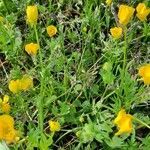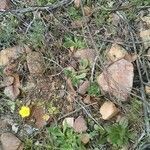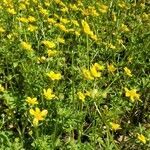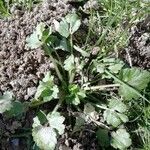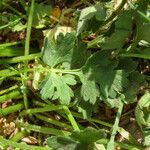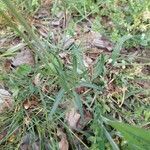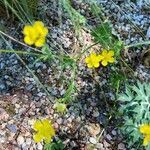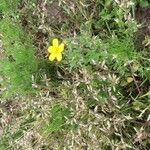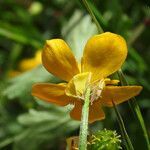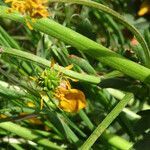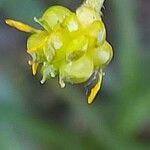Erect, pilose to rarely subglabrous annual (rarely developing short stolons in very wet sites); roots fibrous. Basal leaves with petioles 6–32 cm long; lamina triangular-ovate in outline, 2–8 cm long, deeply 3-lobed or trifoliolate, sometimes distinctly petiolulate; leaflets irregularly cut or toothed or crenate; cauline leaves shortly stalked or sessile and less divided. Flowering stem 5–18-flowered, hollow, 10–50 cm high. Sepals 5, reflexed, ovate, 4–7 mm long. Petals obovate, 8–14 mm long, pale yellow; nectary near petal-base, with lobe obovate to cuneate, c. 1 mm long, attached only at base. Stamens c. 40–60. Pistils 30–40. Receptacle hairy. Achenes in slightly elongated head, flattened, suborbicular, 2–2.5 mm long, greenish brown; faces with small obtuse tubercles near green margin, rarely smooth or evenly tuberculate; beak c. 0.5 mm long, curved upwards.
Annual; roots all fibrous. Stems stout, erect, hairy, 20-45 cm tall. Basal lvs deltoid, distinctly ternate, (2)-3-5-(8) × (2)-3-5-(8) cm; leaflets cuneate, (2)-3-lobed, toothed, hairy; middle leaflet distinctly stipitate and deeply 3-fid; petioles hairy, 6-15-(25) cm long. Cauline lvs similar to basal, but with narrower leaflets, becoming smaller. Fls (1)-6-15-(20) per stem, (12)-15-25 mm diam. Pedicels erect, hairy, sulcate, 3-6 cm long at fruiting. Sepals 5, hairy, deflexed at flowering, acute, c. 5 mm long. Petals 5, pale yellow, obovate, 8-10 × 6-7 mm; nectary single, basal, covered by an obtuse scale. Receptacle hairy. Achenes 30-40, glabrous, strongly flattened, distinctly bordered, broadly obovate to suborbicular; body 2-2.5 × 2-2.5 mm; face bluntly tuberculate near margin; beak curving upward, c. 0.5 mm long.
Stems nearly erect, hispid, base not bulbous. Basal and lower cauline leaf blades ovate to cordate, 3-foliolate, 2-6 × 2-6 cm, leaflets again parted, leaflet base truncate to acute, margins crenate-dentate to crenate-lobulate, apex rounded to obtuse. Flowers pedicellate; receptacle pilose; sepals 5, reflexed, 3-8 × 1.5-3 mm, pilose; petals 5, 7-10 × 4-8 mm. Heads of achenes globose or ovoid, 5-8 × 6-7 mm; achenes 15-35 per head, 2-3 × 2-3 mm, faces sparsely papillate or sometimes smooth, glabrous, margin smooth; beak oblong to deltate, curved, 0.4-0.7 mm.
Annual, usually several-stemmed, 1–6 dm, much branched above; principal lvs mostly clustered near the base, 3-parted, the terminal segment stalked, all segments broadly triangular-obovate, deeply lobed and incised; cauline lvs much smaller, with fewer and narrower segments; fls numerous, long-pedicellate; pet 5–8(–10) mm; receptacle hairy in fr; achenes 30–40, broadly obovate to subrotund, the margin smooth and sharply differentiated, the sides papillate; beak 0.2–0.5 mm; 2n=16, 48. Native of Europe, found here and there in our range as a weed. May–July.
